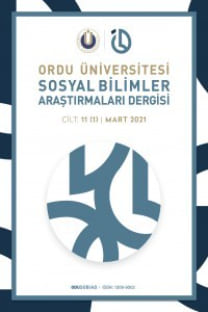Zorunlu Trafik Sigortalarının Fiyatlandırılmasında Negatif Binom Dağılımına Göre Ödül/Ceza Sistemi
Ödül/ceza sistemi, sigortalının geçmiş yıllardaki hasar sayılarını dikkate alarak mevcut yıl için prim tutarında bir azaltma ya da arttırma sağlayarak sonuç üretmektedir. Geçmiş hasar verilerinin bir olasılık dağılımına uygunluğunun tespiti ile sigortalının prim tutarlarını belirleme temeline dayanan sistem, adil prim tutarları elde etmek, daha dikkatli araç sürüşüne yönlendirmek gibi amaçlara sahiptir. Bu çalışmada, Türkiye’deki zorunlu trafik sigortalarına ait ödül/ceza prim değerlerinin, negatif binom dağılımı kullanılarak belirlenmesi amaçlanmıştır. Bu amaç doğrultusunda, sigortalıların yaptıkları hasar sayılarına göre hem sigortalı hem de sigortacı açısından adil bir ödül/ceza sistemi sonuçlarına ulaşılmaya çalışılmıştır. Çalışmanın ilk bölümünde ödül/ceza sistemi açıklanmış, sonrasında söz konusu sistemin uygulanmasında kullanılan negatif binom dağılımı kısaca tanımlanmıştır. Uygulama bölümünde, sektörden elde edilen, zorunlu trafik sigortasına ait 2015 yılı gerçek hasar sayıları kullanılmıştır. Öncelikle veri setinin ödül/ceza sisteminde kullanılacak olan negatif binom dağılımına uygunluğu incelenmiştir. Son bölümde negatif binom dağılımı baz alınarak bir ödül/ceza sistemi oluşturulmuş ve trafik sigortasına ilişkin sigortalıların hasar sayılarına göre değişkenlik gösteren adil prim tutarlarını ifade eden sonuçlara ulaşılmıştır. Sonuç olarak oluşturulan sisteminin bir önceki yıla göre prim değişikliklerindeki cezai artışların, ödül artışlarına göre daha yüksek olduğu tespit edilmiştir.
Anahtar Kelimeler:
Ödül/Ceza Sistemi, Negatif Binom Dağılımı, Zorunlu Trafik Sigortası
Bonus/Malus System in Pricing Compulsory Traffic Insurance According to The Negative Binomial Distribution
The bonus/malus system produces results by providing reduction or increase in premiums for the current year, considering the insured's losses in the past years. The system, which depends on the determination of the suitability of past claims data to a probability distribution the premiums of the insured, has the aim of obtaining fair premiums and directing them towards more careful vehicle driving. The aim of study is to determine the bonus/malus premiums of compulsory traffic insurances in Turkey based on negative binomial distribution. For this purpose, the study tries to establish the results of a fair bonus/malus system according to the damage numbers of insured. Firstly, the bonus/malus system is explained. Subsequently, the system and negative binomial distribution are described. In the application section, the real damage numbers of the compulsory traffic insurance for 2015 were used. Then, the suitability of the data set to the negative binomial distribution was examined. In the last part, a system was established and the results indicating fair premium amounts varying according to the damage numbers have been obtained. Finally, it has been found the malus increases in the premium changes compared to the previous year are higher than the bonus increases.
___
- Kaynakça
- Baykal, K. B, Bülbül, S. E. (2016a). Türkiye’de Trafik Sigortalarında Optimal Ödül-Ceza Sistemi Tasarımı: İyi Risk/Kötü Risk Modeli. Finansal Araştırmalar ve Çalışmalar Dergisi. Cilt 8 (14), 17–31.
- Bülbül, S. E., Baykal, K. B. (2016b). Optimal Bonus-Malus System Design in Motor Third-Party Liability Insurance in Turkey: Negative Binomial Model. International Journal of Economics and Finance. 8 (8), 205–211.
- Déniz, E. G, Hernández-Bastida, A., Fernández-Sánchezz, M. P. (2014). Computing Credibility Bonus-Malus Premiums Using The Total Claim Amount Distribution. Hacettepe Journal of Mathematics and Statistics. 43 (6), 1047–1061.
- Denuit, M., Maréchal, Xavier., Pitrebois, S., Walhin, J.F. (2007). Actuarial Modelling of Claim Counts: Risk Classification, Credibility and Bonus-Malus Systems. New York: John Wiley & Sons Ltd.
- Durak, N. T., Erdoğan, K. (2010). Trafik Sigortaları’nda Ödül-Ceza Sistemi Üzerine Bir Uygulama. Reasürör, (Ekim), 4–13.
- Frangos, N. E., Vrontos, S. D. (2001). Design of optimal bonus-malus systems with a frequency and a severity component on an individual basis in automobile insurance. ASTIN Bulletin. 31 (1), 1–22.
- Frees, E. W. (2009). Regression Modeling with Actuarial and Financial Applications, New York: Cambridge University Press.
- Gómez, E., Hernández, A., Pérez, J.M., Vázquez-Polo, F.J. (2002). Measuring Sensitivity İn A Bonus–Malus System. Insurance: Mathematics and Economics. 31, 105–113.
- Kaas, R., Goovaerts, M., Dhaene, J., Denuit, M. (2008). Modern Actuarial Risk Theory: Using R. 2nd. Edition. Berlin: Springer Science & Business Media.
- Kafková, S. (2015a). A Comparison of Several Bonus Malus Systems. Procedia Economics and Finance. 26, 188–193.
- Kafková, S. (2015b). Bonus-Malus Systems in Vehicle Insurance. Procedia Economics and Finance. 23, 216–222.
- Klugman, S. A., Panjer, H. H., Willmot, G. E.. (2012). Loss Models: From Data Decisions. 4th. Edition. New Jersey: John Wiley & Sons Ltd.
- Lemaire, J. (1979). How to Define a Bonus-Malus System with an Exponential Utility Function. ASTIN Bulletin. 10 (3), 274–282.
- Lemaire, J. (1995). Bonus-Malus Sytems In Automobile Insurance. Boston: Kluwer Academic Publisher.
- Mert, M., Saykan, Y. (2005). On A Bonus-Malus System Where The Claim Frequency Distribution Is Geometric And The Claim Severity Distribution Is Pareto. Hacettepe Journal of Mathematics and Statistics, 34, 75–81.
- Morillo, I., Bermúdez, L. (2003). Bonus– Malus System Using An Exponential Loss Function With An Inverse Gaussian Distribution. Insurance: Mathematics and Economics, 33, 49–57.
- Yung-Ching, H., Yung-Ming, S., Pai-Lung, C., Yen-Ming, J. C. (2015). Vehicle İnsurance And The Risk Of Road Traffic Accidents. Transportation Research, Part A. 74, 201–209.
- ISSN: 1309-9302
- Yayın Aralığı: Yılda 3 Sayı
- Başlangıç: 2010
- Yayıncı: -
Sayıdaki Diğer Makaleler
II. SÜLEYMAN (1687-1691) DÖNEMİ ÖRNEĞİNDE SİYASETEN KATL ve MÜSADERE UYGULAMASI
Gelir Dağılımının Tasarruflar Üzerindeki Etkisi: Hanehalkı Düzeyinde Bir Araştırma
HASAN BASRİ ÇANTAY (18887-1964) VE PRATİK AHLÂK ANLAYIŞI
SAĞLIK ÇALIŞANLARININ İŞ DOYUMU DÜZEYLERİNİN İNCELENMESİ BİR KAMU HASTANESİ ÖRNEĞİ
Avrupa’da Türkçe Derslerinin Dil Edinimine Katkısı (Almanya’da III. Kuşaklar Üzerine Bir İnceleme)
ÖZEL BAKIM MERKEZLERİNDE ÇALIŞAN KADINLARA YÖNELİK BİR ARAŞTIRMA: SAMSUN İLİ ÖRNEĞİ
2017 Fizik Öğretim Programinin Öğretmen Görüşleri Doğrultusunda Değerlendirilmesi (Ordu İli Örneği)
Beş Faktör Kişilik Özelliklerinin İş Yaşamında Yalnızlık Üzerine Etkisinin İncelenmesi
